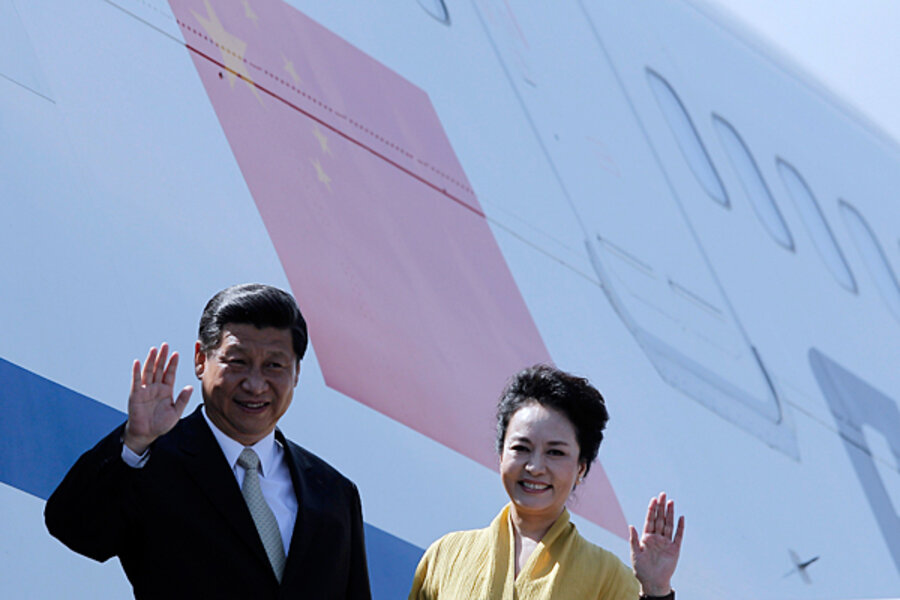Trade is a hot topic as Chinese president travels to Mexico
Loading...
| Mexico City
When China’s president meets with his Mexican counterpart here this week, the two men will try to revive a relationship that has cooled in recent years.
Chinese President Xi Jinping arrives in Mexico today for a three-day visit in which he and Mexican President Enrique Peña Nieto are expected, among other things, to discuss economic cooperation. The visit comes soon after Mr. Peña Nieto’s April trip to China – a quick diplomatic turnaround that experts say augurs a new stage in the relationship.
The two countries are trading partners, but they are also competitors, especially in exports to the lucrative US market. Mexico was the last country to approve China’s entrance to the World Trade Organization in 2001, largely because it foresaw the potential for fierce competition. China's share of goods sold in the United States subsequently ballooned, more than doubling to 19 percent, according to the US Commerce Department; Mexico's share remained stagnant at 12 percent.
Chinese trade with Mexico grew enormously between 2001 and 2012, from $3.2 billion to more than $62 billion. But the balance is heavily tipped by a factor of 10 to 1 toward China. The value of Chinese exports to Mexico amounts to $57 billion, while what Mexico exports to China has a value of $5.7 billion. Mexico is the region’s top exporter of manufactured goods and would like to export far more of its products to China.
“Businesspeople feel – and it’s not just a feeling – that Mexico has a very open commercial structure, including free-trade agreements with 44 countries, and that China is not acting in very reciprocal terms,” says Enrique Dussel Peters of the Center for China-Mexico Studies at Mexico’s National Autonomous University.
Despite lowered tariffs required by the WTO, China has managed to erect other barriers to Mexican exports of pork, seafood, and tequila, among other products. Freer trade will likely be on the table this week.
There are other sticking points in the relationship as well. The two nations traded barbs over the 2009 H1N1 flu virus epidemic after the Chinese government ordered the quarantine of apparently healthy Mexican citizens in the country, and China objected to the Mexican government’s 2011 reception of Tibet’s Dalai Lama.
But things have changed. China became the world’s biggest trading nation last year, eclipsing the US. Mexico has long had a strong trading relationship with the US, with 80 percent of exports moving north to the States. However, because of this, the US recession hit Mexico hard, and there have been increased calls to diversify its trading partners. Mexico’s Peña Nieto has repeatedly promised to look east.
China's 'quest'
Until now, China has largely overlooked Mexico, even as it strengthened ties with other Latin American and Caribbean nations in its hunt for natural resources. Of the $25 billion invested by largely state-owned Chinese companies in the region between 2000 and 2011, Mexico captured less than 1 percent of the investment, according to Mr. Dussel Peters.
China’s Xi may now see promise in Mexico’s energy sector, especially since Peña Nieto has stoked talk of reforms that could open the national oil company to limited foreign investment and potentially boost production (as well as exports to China).
“China is clearly on the quest for oil and natural gas from the region,” says Eric Farnsworth, vice president of the Council of the Americas in Washington.
It’s a way for China to secure future economic expansion, Mr. Farnsworth says – “much less a strategic play in terms of politics and much more an economic play. It’s not to displace the US. I don’t see that as their endgame.”
China and Mexico initiated their modern bilateral ties in 1972, when President Luis Echeverría of the long-ruling Institutional Revolutionary Party (PRI) and his counterpart Mao Zedong formally established a diplomatic relationship.
China and Mexico celebrated four decades of diplomacy last year, which may have also marked the low point of the relationship, says Dussel Peters.
Among the Chinese, there is “a sense that the PRI government is better equipped to deal with China than the PAN,” the National Action Party, which ran Mexico’s previous two governments, says Margaret Myers of the Inter-American Dialogue’s Washington-based China and Latin America program. “There is an excitement about reengaging with the PRI.”
Xi visited Trinidad and Tobago and Costa Rica before he arrived in Mexico today. He is scheduled to meet with President Obama over two days, June 7 and 8.








